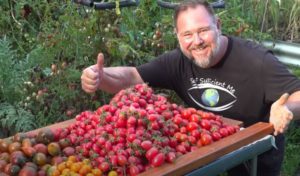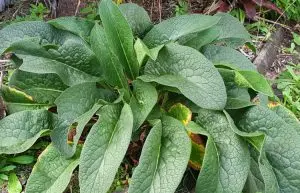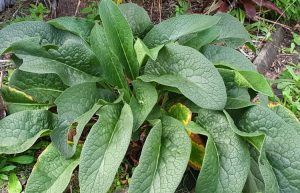Right, I want to make this a straight forward quick post about how to make tamarillo fruit leathers. Often, I write rather long in-depth articles but this recipe is so easy and plus I have written about tamarillos before (Tamarillo or Tree Tomato) so there isn't any need to re-hash about growing the fruit.
We have had a great crop of tamarillos this season; way too many for us to eat fresh so what to do with the extra fruit? Well, I could make a jam, chutney, or even a salsa with this versatile fruit but I decided to make some fruit leathers for the boys (and wife’s) lunches instead.
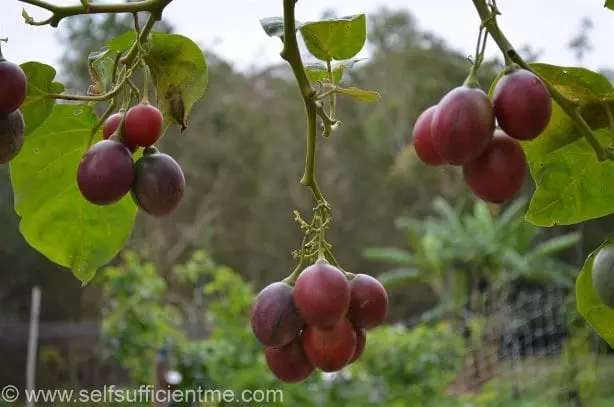
Tamarillo fruit (Image above)
Healthy snack for school lunches
Tamarillos are a super healthy fruit full of antioxidants, vitamins, and they taste great also.
The school our boys go to have a strict eating policy of no junk or packaged food in lunch boxes. And, this policy can sometimes be a challenge for busy parents trying to quickly whack a few lunch boxes together in the morning before school; however, home made healthy treats like fruit rolls/leathers are quick, easy, and as far as the school is concerned it's green-light-go!
Home-made fruit leathers are easy to make in either an oven or a dehydrator (preferably dehydrator) mainly because ovens are more expensive to run than a purpose built dehydrator and in my opinion a dehydrator (like the Excalibur) is safer to use and easier to clean.


Tamarillo plants (image above)
Healthier than commercial products
Fruit leathers made at home are also a healthier option than most commercial products because in home-made fruit leathers there are no artificial preservatives or colours/flavours added. Furthermore, if sugar or a natural sweetener (like honey) is used we generally regulate the amount and don't go overboard turning a healthy snack into one full of sugar.
The reason I mentioned sugar is because sometimes to make a home-made fruit leather more tasty, adding a sweetener of some sort is appropriate since depending on the type of fruit used, without a sweet additive, the fruit leather can become a rather bland uninviting snack for some.
Having said that, strictly using no honey or sugar at all in fruit leathers certainly does make this long lasting healthy snack food even healthier and many people prefer their fruit leathers to be tart. Certainly, if sweet fruits like mangoes, pineapple or plumbs are used then there shouldn't be any need for extra sugar to be added.
With my tamarillo fruit leather recipe, I sometimes use a a small amount of sweetener (like honey) but you can use sugar – that's up to you. Tamarillos alone as a fruit leather is fine if you like a sour type taste; but, I have found my kids more keen to eat them if I “take the edge off” slightly with an added sweetener and bananas in the mix. Some people may like to add a little more or less sweetener to their tastes. The banana not only sweetens the fruit leather but it also thickens the mixture and improves texture.
Simmering the tamarillo pulp is also required for this particular fruit leather in order to easily separate the pulp from the seeds and mix the honey.
The recipe below will make about 3 large plate sized fruit leathers and of course just divide or multiply the ingredients as necessary.
Ingredients 
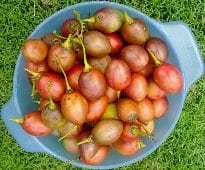
-
Tamarillos – approx 40;
-
Bananas – 4;
-
Honey (Sweetener) – 3 x table spoons (optional); and
-
Water – about ½ cup.
Method
Step 1 – Remove the flesh/pulp from the tamarillos
The pulp from the tamarillos need to be removed and placed into a pan to be simmered. Removing the flesh from the tamarillos can be done in two ways by either peeling off the skin or scooping out the flesh with a spoon.
Peeling Tip – To peel the skin off easily, just place the fruit in a bowl and cover with boiling water letting sit for 4 mins. Then, cool by pouring over cool water and remove the skin by cutting off the stem and making a shallow slice with a knife lengthways along the fruit – the skin should easily come away leaving a whole fruit intact.
Scooping – Cut the fruit in half and scoop out the flesh with a tea spoon.

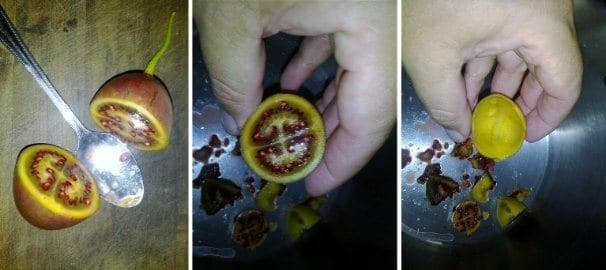
Step 2 – Simmer
Add the water and honey then whilst regularly stirring bring the mixture to a simmer. Simmer and stir until the pulp breaks down into a thick sauce (with lots of seeds) this should only take 30 mins (or less) but the key is to soften the pulp just enough for step 3.

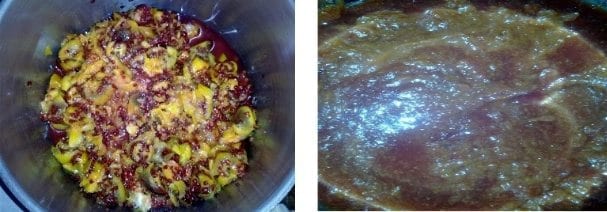
Left image (above) is before simmering and right image is after
Step 3 – Strain
Strain the mixture through a medium sized strainer/colander so all the seeds are caught but the sauce isn't. Using a ladle to massage the sauce through the strainer is helpful. The strained mixture will actually resemble tomato catchup.


Strain the tamarillo sauce by using a ladle to "push" the mix through – seed free thick sauce pictured on right
Step 4 – Blend
Transfer the “sauce” to a blender or food processor add the bananas and blend until smooth with the consistency of a thick shake.

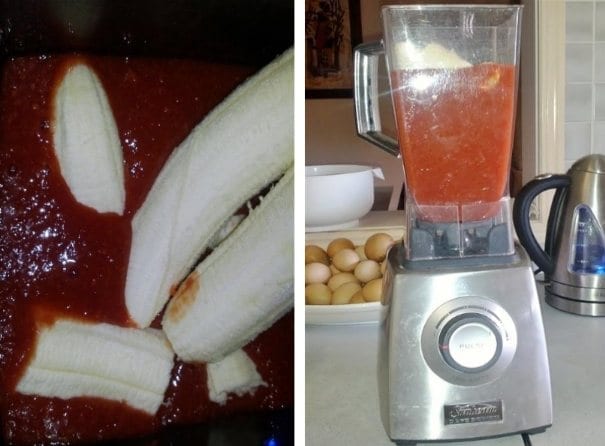
Step 5 – Pour
Using non-stick drying sheets like ParaFlexx from Excalibur (you could use wax paper but it's less effective), carefully pour the thick mixture onto the centre of the sheet until there is enough to manually spread. With a cake knife or other implement, spread the mixture out evenly towards the edges of the ParaFlexx sheet within an inch or so from the sides and about ¼ inch (5 mil) thickness.


Step 6 – Dry
Dehydrator – Place the dehydrator on the “fruits/fruit rolls” setting and set the timer for 12 hours. Check after about 8 hours and monitor every few hours until the fruit leathers go tacky but not sticky to touch. Turn the dehydrator off and let the fruit leathers cool and they're done!
Oven – For those who don't have a dehydrator a standard oven can be used in a similar way but ensure the oven temp is set between 55 and 65 degrees (Celsius).

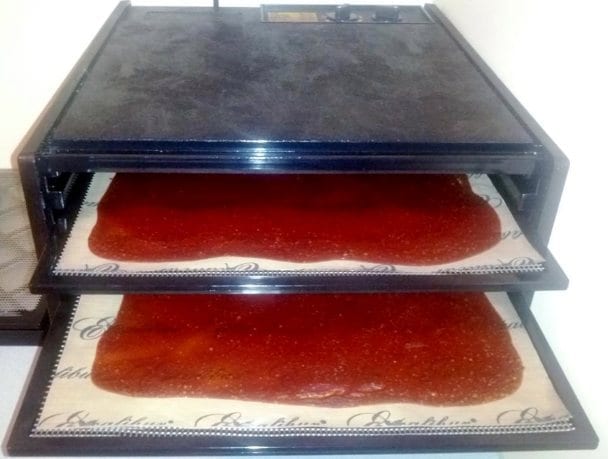
Storage and Eating
The tamarillo fruit leathers should easily peel from the ParaFlexx sheets or wax paper etc. The fruit leather can be rolled and stored whole, pre-cut into strips, or made into whatever cute shapes a person can think of to ensure the children are eager to eat this healthy snack.
Cling film or wax paper can be placed over the whole fruit leather to prevent it sticking to itself and then rolled into a cylinder and stored in the pantry or fridge (or even frozen).
In the pantry, these fruit leathers packaged in a container or placed in zip-bags should last 6 months or more that's if they are not eaten within weeks by the kids (and they probably will be).

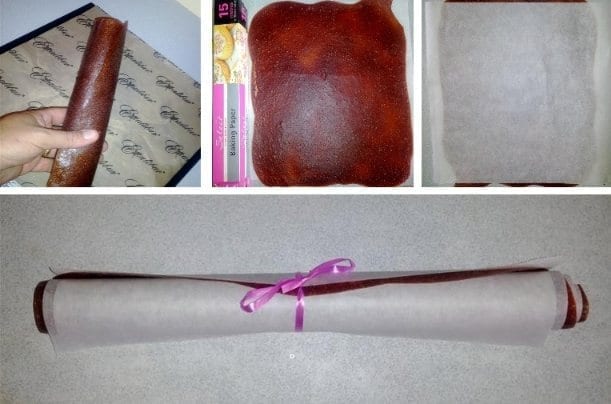
(Above image) Place wax paper or cling wrap on top and bottom and roll and (image below) fruit leather cut into strips and stored in zip bag


Conclusion
Fruit leathers (in this case tamarillo fruit leathers) are a fantastic way to prolong the life of your favourite fruits by preserving excesses before they go to waste. Although a glut of fruit is not mandatory as fruit leathers are just good to make because they are a good, fun, healthy, convenient snack for everyone to eat.
Feel free to use the comment section below (you don't need to supply an email)
Look, and see the Earth through her eyes
Mark Valencia – Editor SSM








